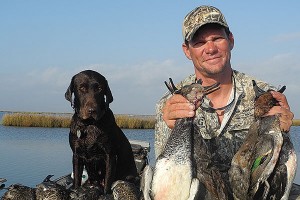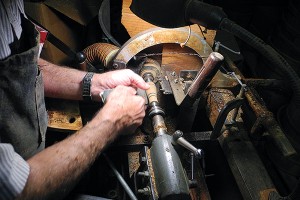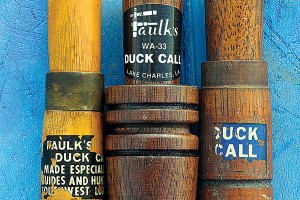September 24, 2012
By Kenneth L. Kieser
 Hunting guides occasionally get strange requests. Paul Grindol, a guide for Hackberry's Rod and Gun Club in Hackberry, La., gave me an odd look when I requested we use only Faulk's wooden duck calls on our hunt. To my surprise, he not only agreed to exclusive use of this old-fashioned call, but had one on his lanyard mixed in with several modern-day acrylics.
Hunting guides occasionally get strange requests. Paul Grindol, a guide for Hackberry's Rod and Gun Club in Hackberry, La., gave me an odd look when I requested we use only Faulk's wooden duck calls on our hunt. To my surprise, he not only agreed to exclusive use of this old-fashioned call, but had one on his lanyard mixed in with several modern-day acrylics.
We were hunting flooded marshes a few miles from Louisiana's Gulf region where shrimp and crab crews catch shellfish delicacies for enjoyment throughout the world. Many fish this region for the Cajun Slam — redfish, flounders and speckled trout — but never realize the great duck hunting a few miles inland in brackish water.
During the drive, the truck headlights flashed over "Alligator Crossing" signs. I decided to keep my hands inside the boat just in case. Soon, Grindol's eager chocolate Lab, Sage, bounded into the jon boat. I piled in behind her with camera equipment and we were slipping through a dark channel of muddy water and standing grass. A spotlight illuminated reflectors off plastic poles driven in the ancient mud.
We finally reached the grass-covered blind. Grindol shined a flashlight across the floor to make sure we did not have crawling company. Most cottonmouths and other notable marsh-dwellers hibernate in November, but you never know where they choose to hole up. He waded out to set up a few spinning wing decoys for movement in the middle of a couple hundred mallard, teal and pintail blocks.
Advertisement
A beautiful sunrise illuminated the decoys. I scanned the skies, but was informed that ducks in this region sleep late. The notable exception was a scaup that happened by shortly after legal shooting time; our first duck of the day. A few simple quacks with a light feeder chuckle on the Faulk's call brought him in without hesitation. Not really a good test. That duck was determined to land in our decoys.
The morning progressed and the ducks indeed slept late as I thought about Paul Dudley "Dud" Faulk hunting around this area with his wooden calls. I could imagine him field-testing the first Faulk prototypes on ancestors of the ducks we were hunting and how he felt when the calls proved to be successful and eventually became duck hunting lore, especially in Louisiana. Grindol broke the silence as if reading my very thoughts.
"Using this type of call is a tradition around here and a very effective late-season call," Grindol said. "Newer calls are often too loud for late-season ducks who have heard every kind of calling imaginable by the time they get here. Wooden calls are lower in volume than the composite type calls that most hunters use these days and deliver a slightly different sound. We still use these wooden calls here during late season, especially on mallards."
Advertisement
I made a couple of quacks on my Faulk's call and immediately understood Grindol's point. A great deal of air was required to equal a modern-day composite style call's volume, especially with a double-reed. The Faulk's call sounded best with less volume, and I was ready to test it on live ducks.
Gaddy Chatter
The morning hunt progressed, bringing several flocks of gadwalls. Normally, gray ducks respond best to a lower-pitched series of quacks, almost impossible to duplicate with a Faulk's single-reed. But they responded well to crisp sounding mallard quacks and feeder chuckles.
 The first flock made three passes around the blind before settling in to land while we talked them in with steady, rhythmic duck sounds. The ducks pumped their wings for safety after several well-placed shots left three floating in the decoys. Sage dove into the chilly water and started making perfect retrieves, once pausing to bring two ducks in at once.
The first flock made three passes around the blind before settling in to land while we talked them in with steady, rhythmic duck sounds. The ducks pumped their wings for safety after several well-placed shots left three floating in the decoys. Sage dove into the chilly water and started making perfect retrieves, once pausing to bring two ducks in at once.
"The only problem with working a good dog in these waters early in the season is alligators," Grindol said while watching Sage. "An alligator will eat your dog."
We quickly limited out on teal, pintails, wigeon, scaup and gadwall. The Faulk's calls had done the job on gadwalls, while teal and pintails responded to light quacks and whistles. I used the same Faulk's mallard call in Missouri on greenheads two weeks later with good success. Not bad for an old-fashioned wooden duck call.
"I started out with a Faulk's duck call like most of us did in this area, an old Faulk's cane call," Grindol said. "You could find them in almost any sporting goods store or gas station around here. I called my first ducks, gadwalls and wigeon, with that call. It still works great."
Fast Forward: Six Decades Later
Faulk's Calls turns 61 this year. Dudley Faulk's father, Clarence "Patin" Faulk, made calls out of bamboo in the 1930s but probably never dreamed that teaching his son to assemble calls and trim reeds would result in a family business that would carry his name around the globe.
Dudley decided to help his dad make calls in 1951 while working for Cities (now CITGO), and started selling them anyplace that sold sporting goods.
Dud and his bride eventually turned their garage into a duck-call factory. Business was mainly regional until the talented callmaker started winning calling contests.
"Faulk's Game Calls grew significantly in 1962 when Dud won the International Duck Calling Championships at the Rice Festival in Crowley, La., using his wooden calls," said his wife, Rena. "He repeated winning this title in 1963 and promptly retired from competition.
"Several callers have won this competition using Faulk's calls. Dud, too, won the World Goose in 1954 in Missouri Valley, Iowa, promoting our line of goose calls."
 Rena and Dud started traveling more frequently to different states in the early 1960s, stopping at every sporting goods dealer to sell their calls. They soon hired reps in the Midwest, East and West coasts to boost sales.
Rena and Dud started traveling more frequently to different states in the early 1960s, stopping at every sporting goods dealer to sell their calls. They soon hired reps in the Midwest, East and West coasts to boost sales.
But Rena believes that sporting goods trade shows made the biggest difference. They sold on consignment and found many interested in Faulk's calls, especially after Dud put on a demonstration.
"Dud could sound like more than one duck when he called," Rena said. "Everyone would stop and listen to his unique technique and many would try to imitate him, usually without success. Then he would show them the sounds were coming from one of our calls.
"We sold a lot of calls that way and most sporting goods stores sold them. Additionally, sales came from Ducks Unlimited attendees at banquets when Dud would stand up and call, sounding like three-dozen mallards cupped up and winging into the building. "
Going Strong
Dudley ran the shop until his death on Sept. 7, 1994. Rena has continued to keep the books and do the office work throughout the company's life span. Staffers Kwanchai Madith from Bangkok, Thailand, and Arthur LeJeune have spent over 40 years working for Faulk's Calls, occasionally joined by their family members. The Faulks' three daughters worked in the family business too. Dudley trained LeJeune to tune and manufacture each call to his standards, and he has redesigned several of the machines to make better calls quicker.
"Can't buy equipment like this," LeJeune said. "You have just got to make it yourself as Dud and I managed to
do. Some of our equipment is made from car parts or anything to make it work."
Touring Faulk's, I found each call is still handmade and tested, just like the version under my grandparents' Christmas tree in 1965 — my first duck call. Raw materials arrive at the shop in Lake Charles, La., and leave as finished products ready for store shelves. Each call is made from blocks of wood on lathes, a sanding machine and other homemade machines with different purposes.
"Most of our calls are made of walnut," LaJeune said while placing blanks on the sanding machines. "Zebra wood is brought in from Africa for nicer calls with the same tuned inserts as the walnut versions. We still make bamboo calls too, from bamboo we grow and dry."
Reeds are cut in the shop from plastic or Mylar sheets and fashioned to fit in each call. Air, vent hole, reed and barrel eventually make the correct sounds after each call is individually tested.
"We have never had a slow year, even when everyone started making custom calls," Rena said.
 Faulk's also started manufacturing others types of calls in the late 1960s when duck numbers were low. Today, they still sell hawk, crow, squirrel, dove, quail, chukar, coon squallers, pheasant, elk, deer and a variety of predator calls.
Faulk's also started manufacturing others types of calls in the late 1960s when duck numbers were low. Today, they still sell hawk, crow, squirrel, dove, quail, chukar, coon squallers, pheasant, elk, deer and a variety of predator calls.
"We are continuing to manufacture our calls like my late husband did," Rena said. "The past three years have been better in sales than the last 10. Many of our sales are overseas, and you can still find Faulk's calls across America, although many of the mom and pop sporting goods stores are gone. We once sold 100,000 calls annually, but now sell 75,000. I will never sell this company, because it gives me someplace to go everyday and something to do," Rena said.
"Not at any price."

